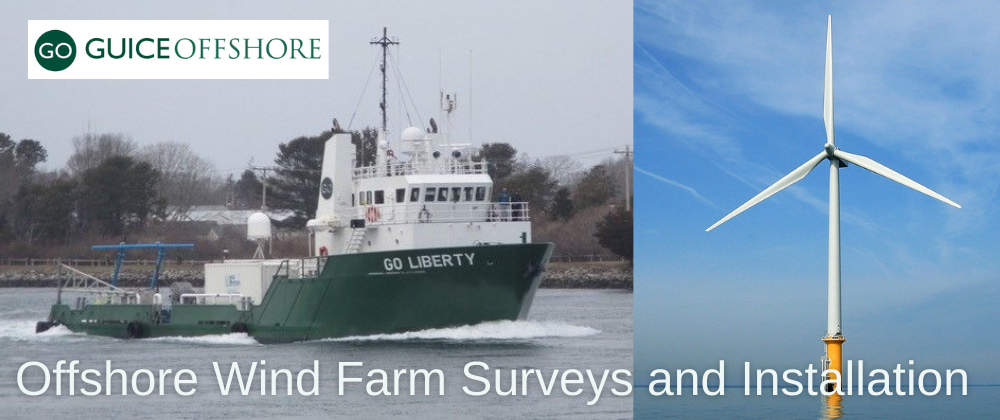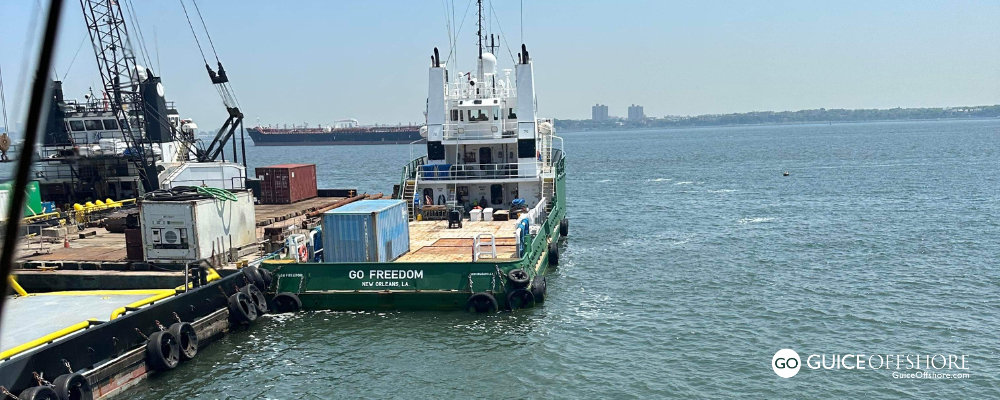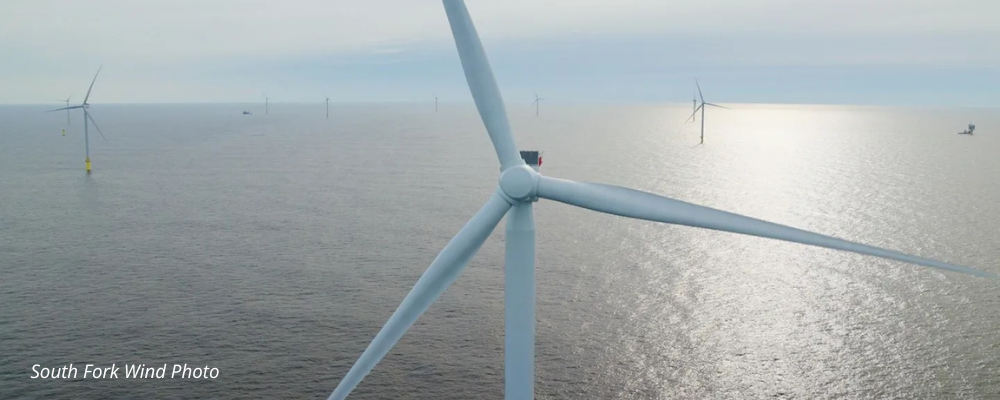In case you missed it, headlines this week reported significant federal plans for two new offshore wind energy facilities off the coasts of New York and New Jersey. The announcement was made on March 29, 2021 during a White House forum in which U.S. Secretary of the Interior Deb Haaland, and the Secretaries of Energy, Commerce, and Transportation, met with representatives from states, the offshore wind industry, and members of the labor community to identify challenges and solutions facing this new industry—with which Guice Offshore and its fleet of mini supply vessels, offshore supply vessels and multi-purpose vessels has experience.
New Wind Energy Area in New York Bight
- For details on the New York Bight Wind Energy areas, click here.
The Interior Department’s Bureau of Ocean Energy Management (BOEM) announced a new priority Wind Energy Area in the New York Bight—an area of shallow waters between Long Island and the New Jersey coast—which a recent study from Wood Mackenzie shows can support up to 25,000 development and construction jobs from 2022 to 2030, as well as an additional 7,000 jobs in communities supported by this development.
The study indicates the New York Bight lease area also has the potential to support up to 4,000 operations and maintenance jobs annually, and approximately 2,000 community jobs, in the years following. This new Wind Energy Area is adjacent to the greater metropolitan Tri-State area— the largest metropolitan population center in the United States that is home to more than 20 million people and their energy needs. The next step is for BOEM to publish a Proposed Sale Notice, followed by a formal public comment period and a lease sale in late 2021 or early 2022.
New Jersey Ocean Wind to Advance
- To read more about the proposed New Jersey offshore wind energy facility, click here.
The BOEM announced a Notice of Intent to prepare an Environmental Impact Statement for Ocean Wind, putting it in line to become America’s third commercial scale offshore wind project. Ocean Wind has proposed an offshore wind project with a total capacity of 1,100 megawatts (MW) — enough to power 500,000 homes across New Jersey. The BOEM previously announced environmental reviews for Vineyard Wind in Massachusetts and South Fork Wind in Rhode Island, and anticipates initiating the environmental reviews for up to ten additional projects later this year.
The Departments of Interior (DOI), Energy (DOE), and Commerce (DOC) announced a shared goal to deploy 30 gigawatts (GW) of offshore wind in the United States by 2030, while protecting biodiversity and promoting ocean co-use.
Investing in American Infrastructure to Strengthen the Domestic Supply Chain and Deploy Offshore Wind Energy
Meeting the wind power target is expected to trigger more than $12 billion per year in capital investment in projects on both U.S. coasts, create tens of thousands jobs, with more than 44,000 workers employed in offshore wind by 2030 and nearly 33,000 additional jobs in communities supported by offshore wind activity. It is also expected to generate enough power to meet the demand of more than 10 million American homes for a year, while avoiding 78 million metric tons of CO2 emissions.
To position the domestic offshore wind industry to meet the 2030 target, the BOEM plans to advance new lease sales and complete review of at least 16 Construction and Operations Plans (COPs) by 2025, which represents more than 19 GW of new clean energy.
Meeting the 2030 target is also expected catalyze significant supply chain benefits. For offshore wind power and clean energy projects currently under construction, Guice Offshore vessels have been instrumental in assisting with the offshore survey process, for example.
Other benefits include new port upgrade investments totaling more than $500 million; one to two new U.S. factories for each major windfarm component including wind turbine nacelles, blades, towers, foundations, and subsea cables; additional cumulative demand of more than 7 million tons of steel—equivalent to 4 years of output for a typical U.S. steel mill; and the construction of 4 to 6 specialized turbine installation vessels in U.S. shipyards, each representing an investment between $250 and $500 million.
Achieving this target is expected to unlock a pathway to 110 GW by 2050, which is calculated to generate 77,000 offshore wind jobs and more than 57,000 additional jobs in communities supported by offshore wind activity. The goal is to create further economic opportunity and ensure future generations have access to clean air and abundant renewable power.
Related developments include:
- Investing in Port Infrastructure to Support Offshore Wind. The U.S. Department of Transportation’s (DOT) Maritime Administration has announced a Notice of Funding Opportunity for port authorities and other applicants to apply for $230 million for port and intermodal infrastructure-related projects through the Port Infrastructure Development Program. Port Infrastructure Development Grants support projects that strengthen and modernize port infrastructure, and can support shore-side wind energy projects, such as storage areas, laydown areas, and docking of wind energy vessels to load and move items to offshore wind farms. In addition to supporting the nation’s long-term economic vitality, DOT’s review process will consider how proposed projects can most effectively address climate change and environmental justice imperatives.
- Access to $3 billion in Debt Capital to Support Offshore Wind Industry through DOE Loan Programs Office. The DOE’s Loan Programs Office (LPO) released a fact sheet to facilitate access for the offshore wind industry for $3 billion in funding through LPO’s Title XVII Innovative Energy Loan Guarantee Program. The fact sheet signals that LPO is open for business and ready to partner with offshore wind and offshore transmission developers, suppliers, and other financing partners to scale the U.S. offshore industry and support well-paying jobs. To date, the LPO has provided $1.6 billion in support of projects totaling about 1,000 MW of onshore wind.
Supporting Critical Research and Development and Data-Sharing
Announcing offshore wind R&D funding through the National Offshore Wind R&D Consortium. DOE also announced $8 million for 15 new offshore wind research and development (R&D) projects through the National Offshore Wind R&D Consortium. The selections include projects to develop innovative support structures, support U.S.-based supply chains needed for wind turbine production, advance electrical systems innovation, and present solutions for impacts on wildlife and radar.
The DOE established the National Offshore Wind R&D Consortium in 2018 to address research priorities for offshore wind as defined in the National Offshore Wind Strategy, which was developed jointly by DOE and the DOI. The DOE selected the New York State Energy Research and Development Authority (NYSERDA) to administer the consortium, with DOE and NYSERDA each providing $20.5 million to fund research projects that lower the costs of U.S. offshore wind. State agencies in Maine, Maryland, Massachusetts, and Virginia have since joined the consortium, resulting in a total investment of around $47 million.
The full list of projects and the technical challenge areas they aim to address can be found on the Wind Energy Technologies Office website.
Partnering with Industry on Data-Sharing. The Department of Commerce’s National Oceanic and Atmospheric Administration (NOAA) is signing a Memorandum of Agreement with Ørsted, an offshore wind development company, to share physical and biological data in Ørsted-leased waters subject to U.S. jurisdiction. This agreement is the first of its kind between an offshore wind developer and NOAA, and paves the way for future data-sharing agreements that NOAA expects to enter into with other developers. NOAA anticipates that Ørsted’s and other companies’ data will fill gaps in ocean science areas—particularly in ocean mapping and observing—in service of NOAA’s mission to advance climate adaptation and mitigation, weather-readiness, healthy oceans, and resilient coastal communities and economies.
Studying Offshore Wind Impacts. NOAA’s Northeast Sea Grant programs, in partnership with DOE, DOC, and NOAA’s Northeast Fisheries Science Center, is releasing a request for research proposals to support more than $1 million in grant funding to improve understanding of offshore renewable energy for the benefit of a diversity of stakeholders, including fishing and coastal communities. Grant funding will support objective community-based research in the Northeast to further understanding of the effects of offshore renewable energy on the ocean and local communities and economies as well as opportunities to optimize ocean co-use.
Protecting Coastal Communities. The DOE and the Department of Commerce jointly announced a new partnership through the Northeast Sea Grant program that will fund $1.25 million in research into the impacts of ocean-based renewable energy—such as offshore wind, wave, current, and tidal energy—on the fishing industry and Northeastern coastal communities.
As part of this venture, DOE’s Wind Energy Technologies Office and Water Power Technologies Office, NOAA’s Northeast Fisheries Science Center, and the Northeast Sea Grant Consortium will collectively tap into local expertise to better understand how to align ocean renewable energy deployment and technology development with community values. The program has released a co-funded Request for Proposals for social science and technology research that explores the impacts ocean renewable energy will have on community resilience and economies. Higher education institutions in Connecticut, Maine, Massachusetts, New Hampshire, New York, and Rhode Island are eligible to apply.
For more information on DOE’s support for wind energy R&D, visit the Wind Energy Technologies Office website.



